Eager to get a full picture of the 2018 vintage, the Wine Lister team immersed itself in London’s Burgundy week last week, attending eight tastings between us. Having been spoilt by a handful of tastings in the cellars of top domaines in July and December 2019, we braced ourselves for a reality check in the light of the challenging growing season.
Burgundy was baking hot in the summer of 2018, with the highest amount of sunlight for half a century, according to Olivier Lamy of Domaine Hubert Lamy. Making great wine in this vintage was all about the producers’ choices, and great wines there are, but not across the board. Key decisions included production volumes (not too high, or too low!), picking dates (early, or at least not too late), and canopy management (or rather lack thereof, letting the leaves protect the grapes from too much sunlight).
The 2018 vintage has been touted as one of quality and quantity. White wine volumes were indeed high, and this arguably helped avoid over-ripeness (though too much volume risked dilute flavours). However, red quantities are not always more generous than average in 2018, with many producers managing yields with green harvesting. As for picking dates, August start dates were more commonplace than ever before. Picking in time was crucial – throughout our tastings, the Wine Lister team found that occasional wines showed signs of fruit left hanging a day or two too long. However, no blanket rule applies, and producers such as Grivot, who waited until mid-September, made some of the finest wines of the vintage.
It was clear early on that a hot summer was potentially in store, so arguably an easy call to leave a sufficient amount of foliage to protect the grapes from the relentless sun. More producers are following in the footsteps of Lalou Bize-Leroy and forgoing trimming altogether. For example, Charles Lachaux of Arnoux-Lachaux has been experimenting with making arches of his vines, which necessarily creates more shade.
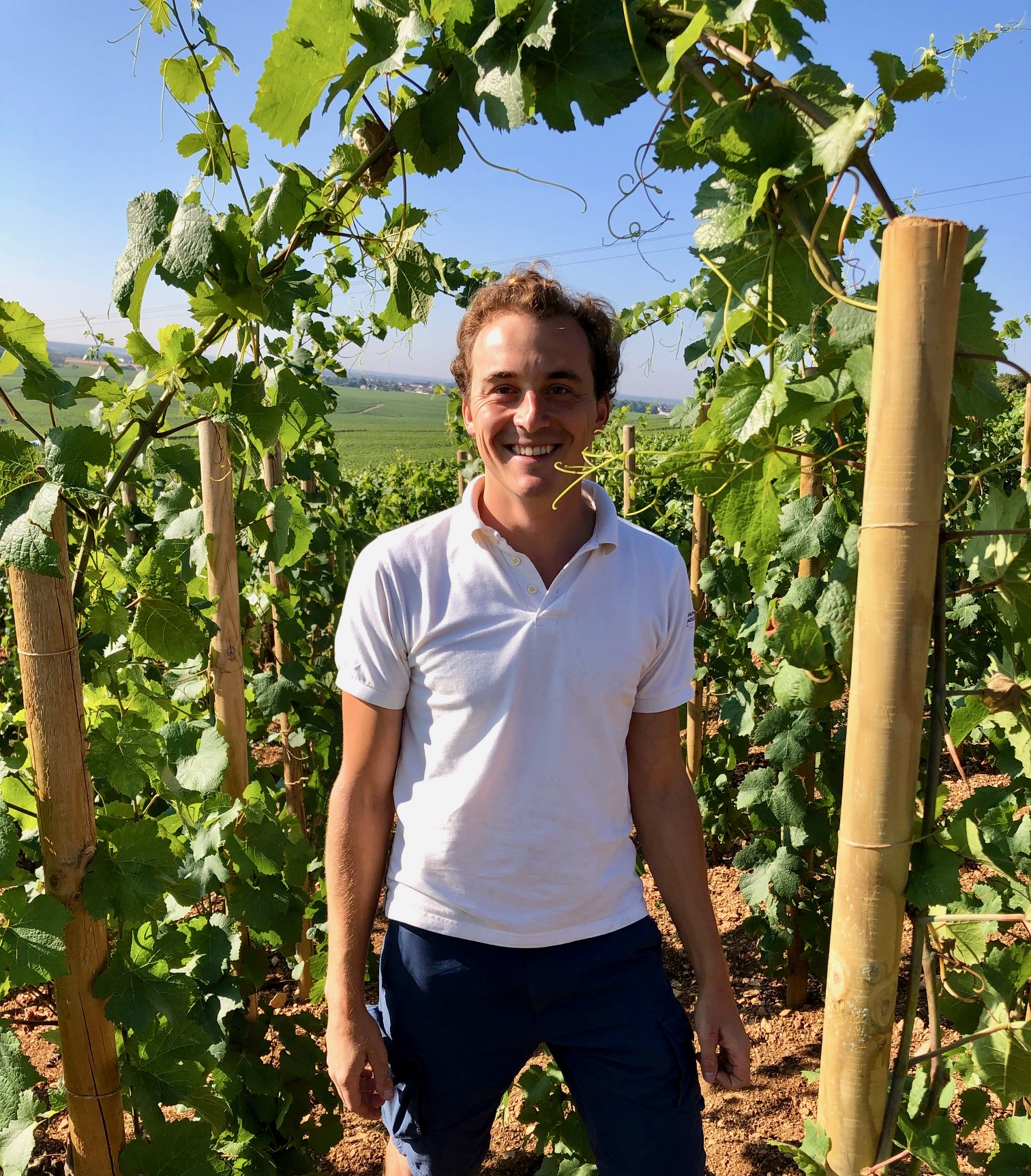 Pictured: Charles Lachaux says when building his vines into arches, “there’s only one rule: there are no rules”.
Pictured: Charles Lachaux says when building his vines into arches, “there’s only one rule: there are no rules”.
In some cases the sunshine overwhelmed, but in many more, savvy producers – used to making wine in the context of global warming by now – managed the conditions deftly. Romain Taupenot of Domaine Taupenot-Merme has observed that even the soils have learned to adapt to warmer conditions over time, regaining acidity more quickly than in hot vintages of the past, such as 2003.
The 2018 Burgundy vintage is heterogenous, but we were surprised by how few wines were negatively marked by the extreme conditions of the vintage. The majority of wines manage to harness good acidity and lightness of touch, if not the intense freshness and succulence of 2017. However, the words “limpid”, “bright”, and “lifted” appear far more often in my tasting notes than “rich”, “ripe”, or “heavy”.
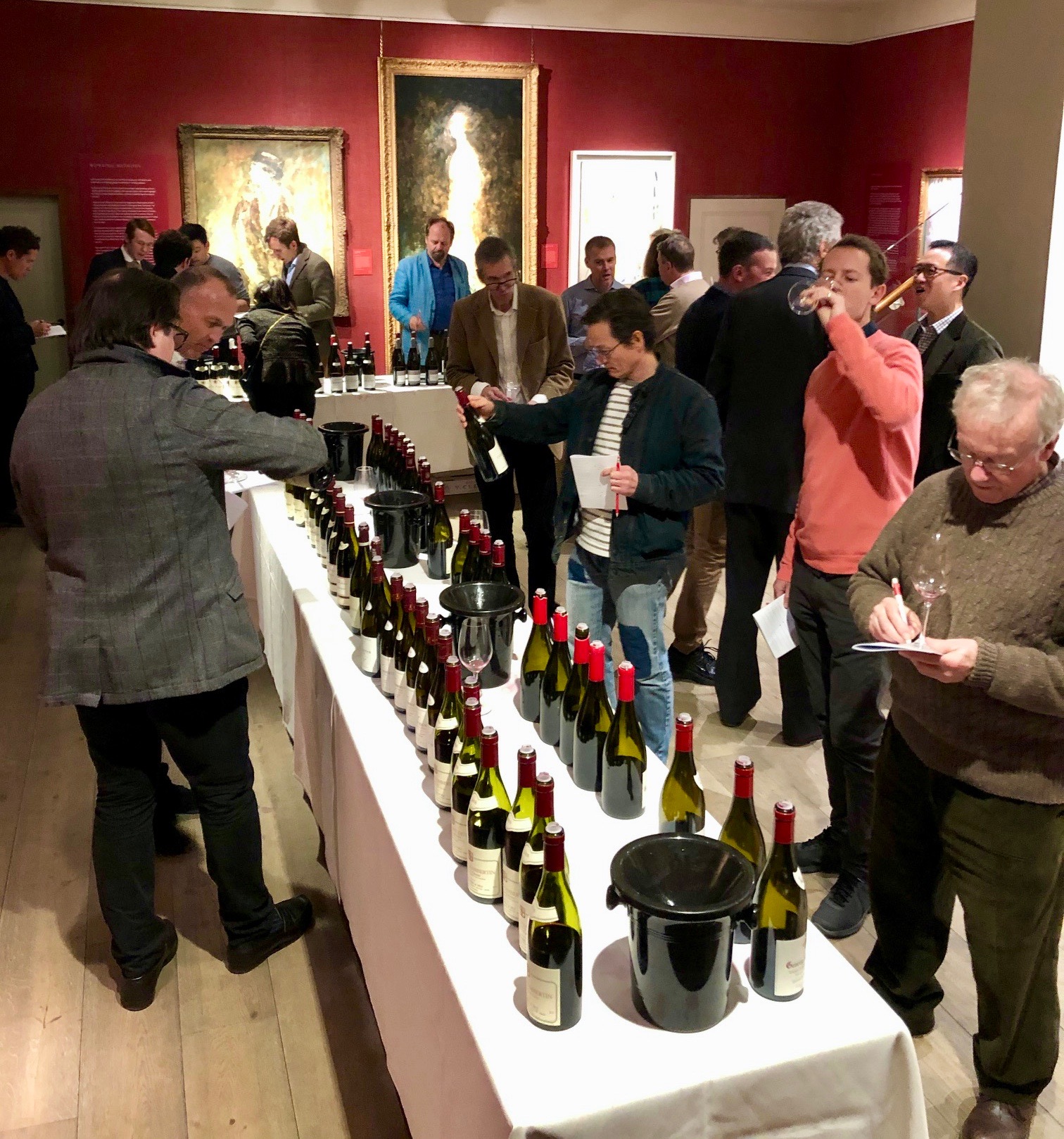 Kicking off Burgundy week tastings with Goedhuis at the Philip Mould Gallery, featuring producers such as Tortochot, Domaine de l’Arlot, Benjamin Leroux, and Jean-Marc & Thomas Bouley to name but a few.
Kicking off Burgundy week tastings with Goedhuis at the Philip Mould Gallery, featuring producers such as Tortochot, Domaine de l’Arlot, Benjamin Leroux, and Jean-Marc & Thomas Bouley to name but a few.
If pushed to choose, this is a red vintage, with higher heights than for whites, which are more consistent but less often exciting, though absolutely not to be ignored. The best reds have harnessed all the energy, vibrancy and texture of the long, hot summer, without being overly sweet or jammy.
After tasting hundreds of wines last week, there are no obvious standout appellations, but rather standout producers. That does not mean that appellations did not stand out – many producers were able to translate terroir impressively given the strong imprint the vintage tried to leave. The wines of Bruno Clair for example, let the different vineyards sing, with a Chambolle “de chez Chambolle” and a very “Vosne” Vosne-Romanée Les Champs Perdrix.
Watch this space for our recommendations, coming soon.
As we enter into this new year, 2020, it hardly seems possible that wines from the 2010 vintage are now a decade old. Having updated the Wine Lister MUST BUYs for the first time in 2020, we have examined all current recommendations from 2010. Wine Lister’s ground-breaking buy recommendations are data-driven, with an intelligence-based overlay. The algorithm takes into account a wine’s quality and value within its vintage and appellation, as well as the latest industry intelligence from key players in the global fine wine trade. The Wine Lister team then scours the results to identify must-buy wines based on our own tasting experience and market knowledge.
2010 is the number one vintage for MUST BUYs, with 169 – or 10% – of the current count (1,710). An impressive 49 of these achieve WL scores of 96 or above, and are listed below.
As is becoming a regular pattern for MUST BUYs – thanks to the region’s value proposition – Tuscany dominates the list of reds, with nine wines featured from the 2010 vintage earning 96+ WL across the Chianti and Brunello DOCG, and Tuscany IGT appellations. Super-value producer Le Macchiole achieves MUST BUY status for two of its three cuvées in the 2010 vintage (Scrio and Paleo Rosso), while at the other end of the price spectrum is Masseto 2010.
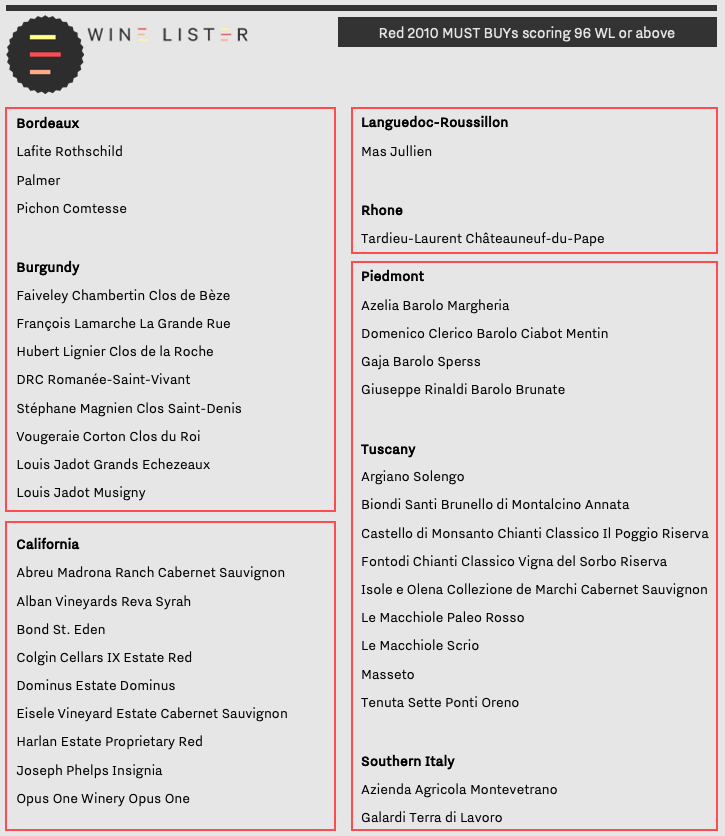
California also achieves nine MUST BUY entries for 2010, including wines from the likes of Dominus, Colgin, Harlan Estate and Opus One. Burgundy follows with one red fewer, and includes François Lamarche’s monopole La Grande Rue.
Piedmont features four Barolos, amongst which is the legendary Giuseppe Rinaldi’s Barolo Brunate (labelled Brunate-Le Coste prior to the 2010 vintage). Bordeaux falls short of its usual ratio of MUST BUYs in 2010, featuring just three wines. Being such an iconic vintage, 2010 Bordeaux in general does not offer the “good value” necessary to make the Wine Lister MUST BUY cut when up against better-value vintages such as 2008 or 2014. However, for Lafite, Palmer, and Pichon Comtesse, the 2010 vintage is of significantly higher quality than other vintages to make it worth paying the price premium – less marked than for many other 2010s. For example, the average premium of 2010 over 2011 for Lafite, Palmer, and Pichon Comtesse is 42%, whereas for Mouton, Léoville Las Cases, and Pichon Baron you have to pay 60% more to get your hands on the better vintage.
Several whites make the cut in 2010, of which the majority hail from the reigning region of Chardonnay. Burgundy’s Maison Louis Jadot sweeps three of the seven white Burgundy 2010 spots, proving once again the excellent value presented by some of Burgundy’s top quality négociants.
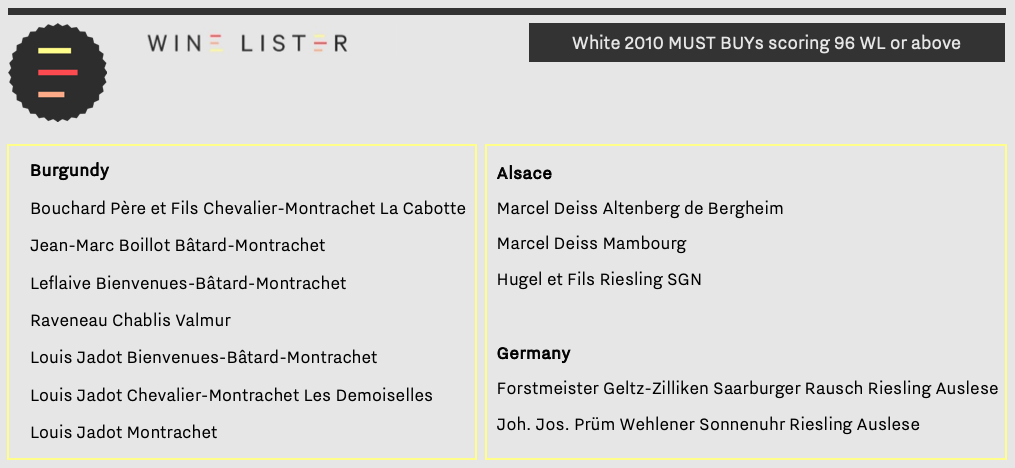
Riesling-based whites also prove a popular option, with entries across Alsace and Germany, however lucky owners of some of these (namely Marcel Deiss’ Altenberg de Bergheim and Zilliken’s Saarburger Raucsch Riesling Auslese), should have patience, and could perhaps even wait until the start of the next decade before opening either of these spectacular wines.
See the full list of 2010 MUST BUYs here.
For the last three consecutive updates, Burgundy has worn the crown for highest number of new MUST BUY entries. This week it shares its prime position with Tuscany, as the two regions hold six wines each of the 27 new MUST BUYs. Whilst previous updates have been geographically diverse, this week’s countries of focus are France and Italy only.
All but one of this week’s new Tuscan MUST BUYs can be considered “Super Tuscans”. Buzz Brands Querciabella and Sassicaia make the cut for their 2015 and 2007 respectively. Producer Fattoria La Massa earns another place this week for Giorgio Primo, making its 2016 the sixth MUST BUY vintage of this same wine. 2015 Percarlo from San Giusto a Rentennano and 2016 l’Apparita from Castello di Ama complete the new “Super Tuscans”. A second offering from Castello di Ama is this week’s only new Chianti Classico entry, and brings the producer’s MUST BUY total to eight, equalling Italy’s other top MUST BUY producers, Castello dei Rampolla, and Isole e Olena, in number.
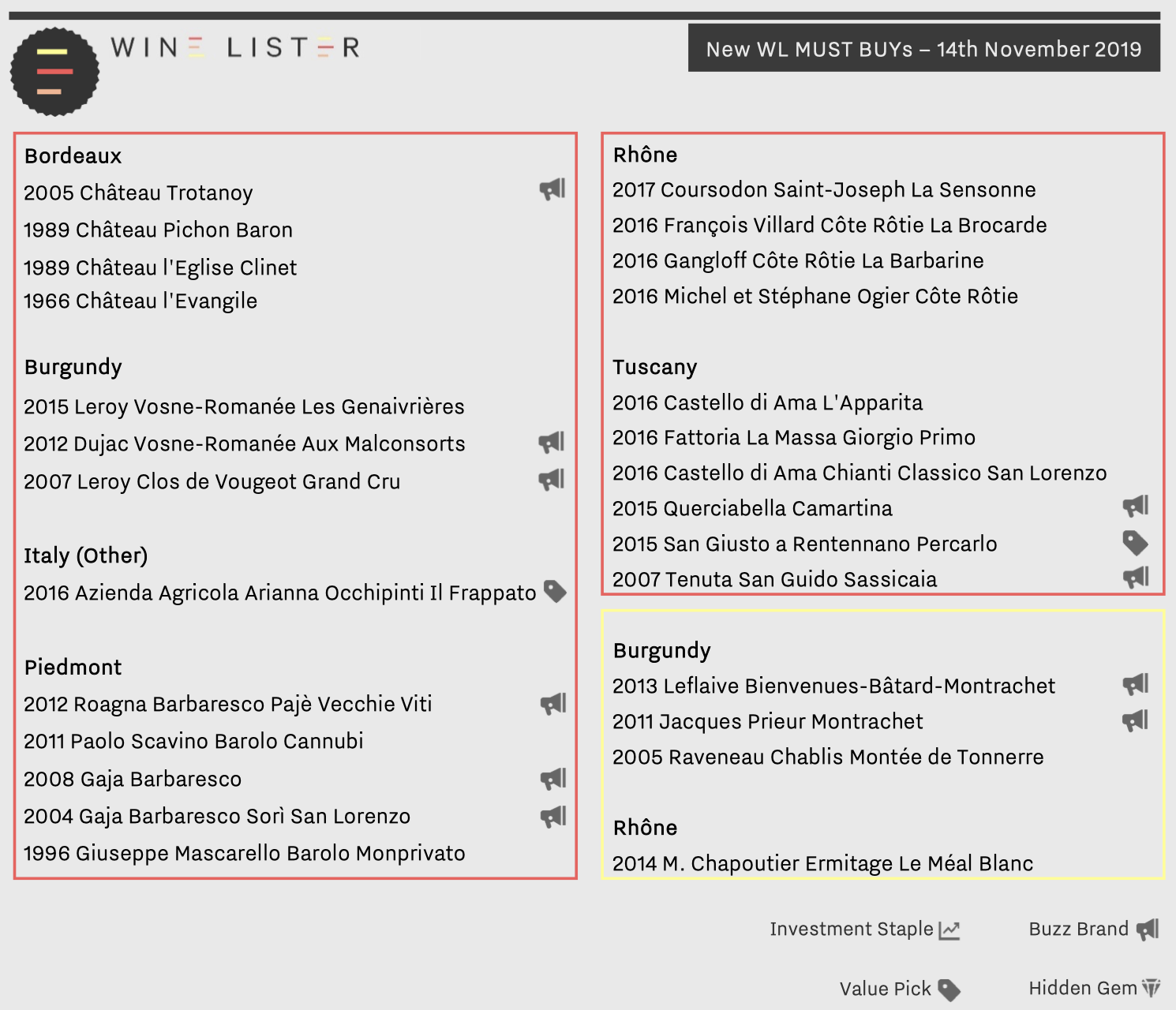
Further North in Italy, Piedmont is by no means overlooked, with Roagna and Paolo Scavino featuring on the new MUST BUY list for Barolo this week (in 2012 and 2011 vintages respectively), alongside Giuseppe Mascarello’s 1996 Barolo Monprivato. Gaja is represented twice, and completes the Piedmont five with the straight Barbaresco and the Sorì San Lorenzo.
France’s chief MUST BUY region, Burgundy, offers three reds and an equal number of whites, with Leroy representing two of the three Pinot Noirs (2015 Vosne-Romanée Les Genaivrières and 2007 Clos de Vougeot). Vosne-Romanée earns another mention through Dujac for its 2012 Aux Malconsorts. Domaine Leflaive, Jacques Prieur, and an older vintage of Raveneau take this week’s new white Burgundy MUST BUY places.
Outside Burgundy, France is also well-represented by the Rhône, with a 2017 from Coursodon, together with 2016s from François Villard, Gangloff, and Michel et Stéphane Ogier. Chapoutier’s 2014 Ermitage Le Méal Blanc completes the latest additions of MUST BUY whites. Older vintages of Bordeaux also make the cut, including a 1966 from l’Evangile, and one 1989 from each bank – l’Eglise Clinet and Pichon Baron.
To help keep track of the weekly updates, check out our latest tool on the search page to help you browse only the newest additions to the full MUST BUY list.
This week’s MUST BUY update renders two and a half times as many results as the previous week. For the third consecutive time, Burgundy dominates, with 19 out of the 77 first MUST BUYs of November. To help you browse through all MUST BUYs (currently totalling 1,739 wines), you can now use the MUST BUY browsing blocks from our free user homepage and/or search page.
Six of the most recent Burgundian additions hail from the latest available vintage – 2017. The likes of Vincent Dauvissat, Olivier Leflaive, and Remi Jobard make the cut for whites, while red 2017s are represented by two cuvées from Domaine de l’Arlot (Vosne Romanée Suchots and Romanée-Saint-Vivant), and Nicolas Rossignol’s Pommard.
Meursault dominates white vintages with a bit more age, from Roulot, Pierre-Yves Colin Morey, and the iconic Arnaud Ente. Other red Burgundy back vintages between 1990 and 2015 range from DRC’s Romanée-Saint-Vivant, to Bruno Clair’s Gevrey-Chambertin Clos Saint-Jacques.
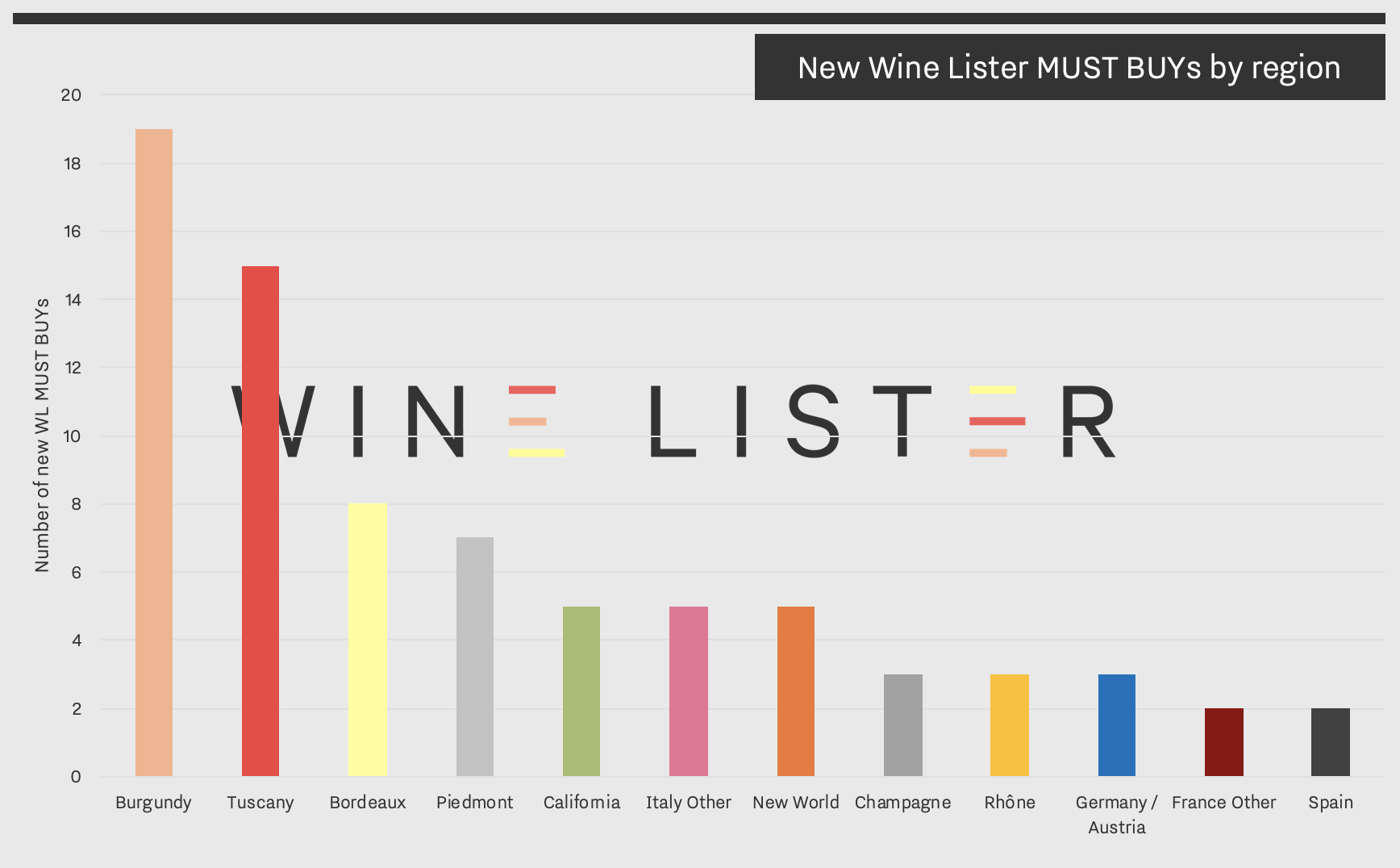
Italy too makes a strong showing this week. 11 of the new Italian MUST BUYs are “Super Tuscans”, amongst which two vintages of Tua Rita’s Syrah qualify (2016 and 2012), as well as 2011s from Masseto and Querciabella Camartina. Also appearing are two back vintage Chianti Classico crus, from Castello di Ama and Fontodi. Piedmont and regions further afield in Italy are by no means neglected, with 12 new MUST BUYs between them.
Wine Lister MUST BUYs must pass not only the algorithm itself, but also the Wine Lister team’s seal of approval. Following recent trips and tastings by different Wine Lister team members, we were especially excited to select wines from Vajra (the Barolo Bricco delle Viole 2015), as well as Gaja, Domenico Clerico, Argiolas, Galardi, and Elisabetta Foradori, as well as three Champagnes – A.R. Lenoble’s Blanc de Blancs, Agrapart’s L’Avizoise, and Béreche’s Le Cran, and finally a stunning dry riesling from A. Christmann.
Download the list of new MUST BUYs here: Wine Lister Blog – New month, new MUST BUYs
Alternatively, you can search and browse through the full MUST BUY list here.
Chloe Ashton
November 6, 2019
Since its launch in September, Wine Lister’s MUST BUY list has unveiled fine wines across multiple regions, vintages, price points, and drinking occasions, all with the common theme of being so good, that they simply must find their place in fine wine fanatics’ cellars. Wine Lister’s prices are updated weekly, and since price (in the form of value) plays a major part in the MUST BUY algorithm, MUST BUYs too will henceforth be updated weekly.
Since its last update, the MUST BUY list has grown by four wines (to 1,697), with 22 new entries, and 18 wines that have fallen off the list. Following the same trend as last week, nine out of the 22 new MUST BUYs (or 41%) are Burgundian. Big names in Burgundy continue to do well, with three new white Buzz Brands hailing from Raveneau, Jean-François Coche-Dury, and Pierre Yves Colin-Morey respectively.
Elsewhere within white entries are two Rieslings, the Alsatian Hidden Gem, Albert Mann’s l’Epicentre 2008, and the indomitable Joh. Jos Prüm’s Wehlener Sonnenuhr, whose 2011 is now one of seven MUST BUY vintages of this sensational Value Pick.
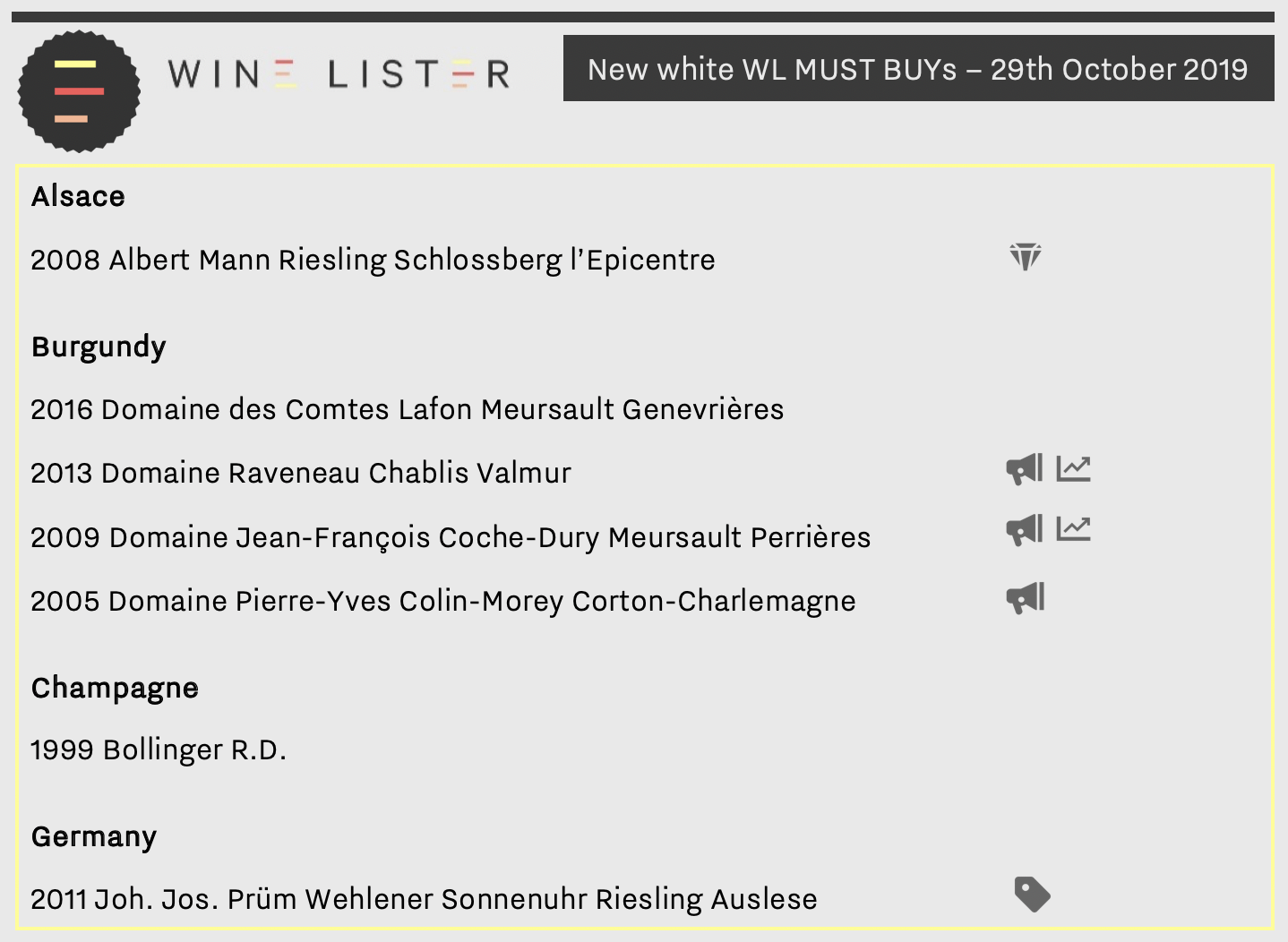
With the clocks turned back and a wintry chill in the air, there are twice as many new red MUST BUYs as white. Burgundy and Italy make the strongest showing, with five reds apiece. Maison Joseph Drouhin sees the addition of its Chambolle-Musigny Les Baudes 2008, bringing the house’s MUST BUY total to 21 wine vintages. Meanwhile Italy’s new MUST BUYs hail from four big name growers: Gaja, Roberto Voerzio, Castello di Ama, and Isole e Olena.
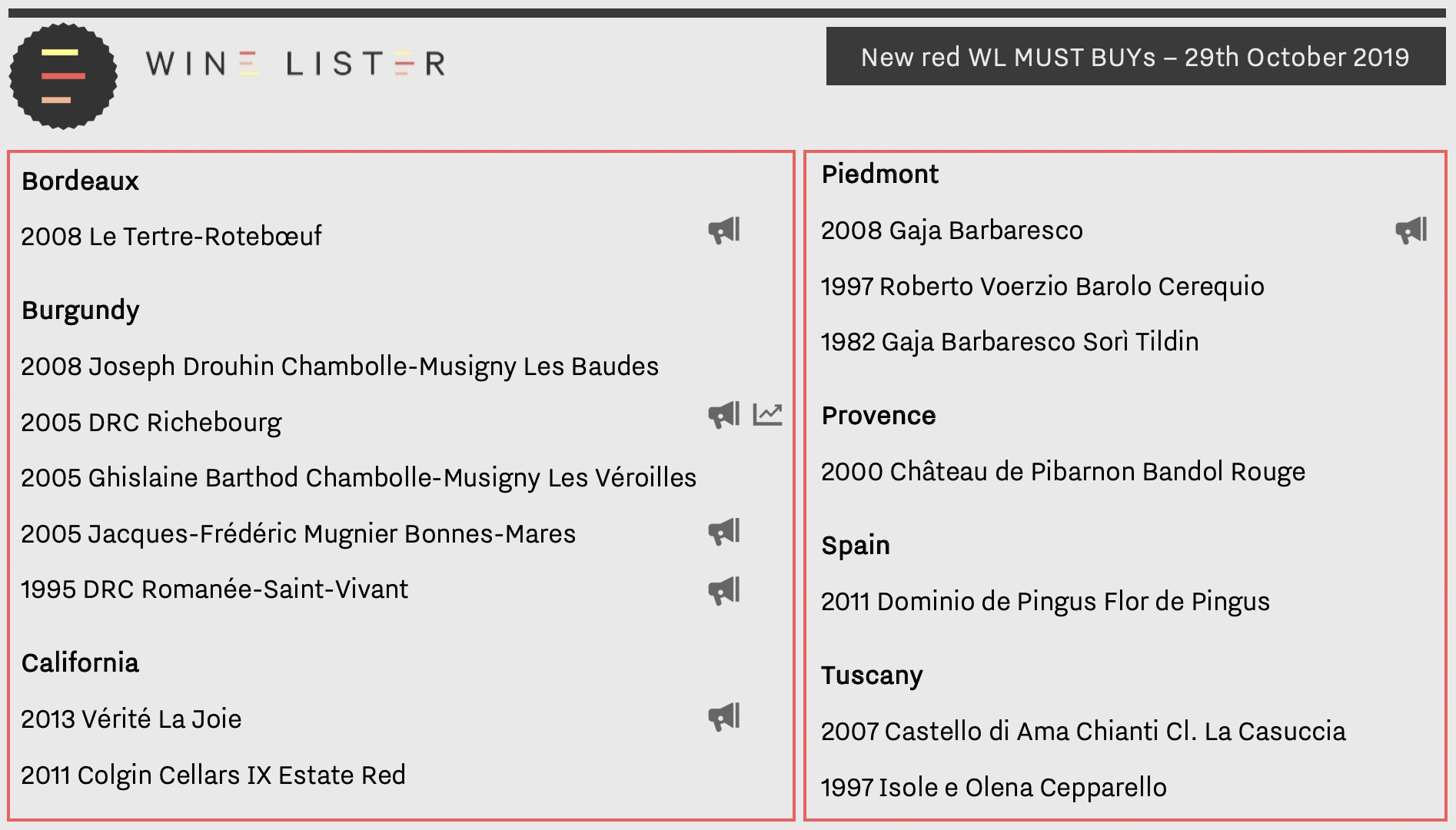
Bordeaux achieves just one entry in Le Tertre-Rotebœuf 2008 (one of nine Bordeaux 2008 MUST BUYs). California also makes its mark, with Vérité’s La Joie 2013 and Colgin Cellars IX Estate Red 2011. Outside of “classic” fine wine regions, Château de Pibarnon’s Bandol Rouge 2000 also enters the fray.
See the full list of current MUST BUYs here.
2017 was perhaps the most difficult of recent Bordeaux vintages. Looking back at our harvest report on this frost-ridden vintage, the Wine Lister team attended the annual UGC re-tasting with some trepidation last week.
Indeed, new president of the Union des Grands Crus Classés, Ronan Laborde, reminded us that 2017 had been a “vintage of challenges”, requiring “patience, determination, and energy” to battle against the frost. Even still, some producers lost their entire crop, and many that didn’t produced their “smallest quantities of recent years”.
Troubled though the vintage might have been, you wouldn’t know it from the hoards of London trade that flocked to taste Bordeaux’s latest deliverable vintage, nor indeed from many of the wines we tasted, which followed a general trend of being exceedingly approachable.
Out of some 120 wines tasted, the Wine Lister team highlights its selection of 17 top dogs, and four underdogs below.
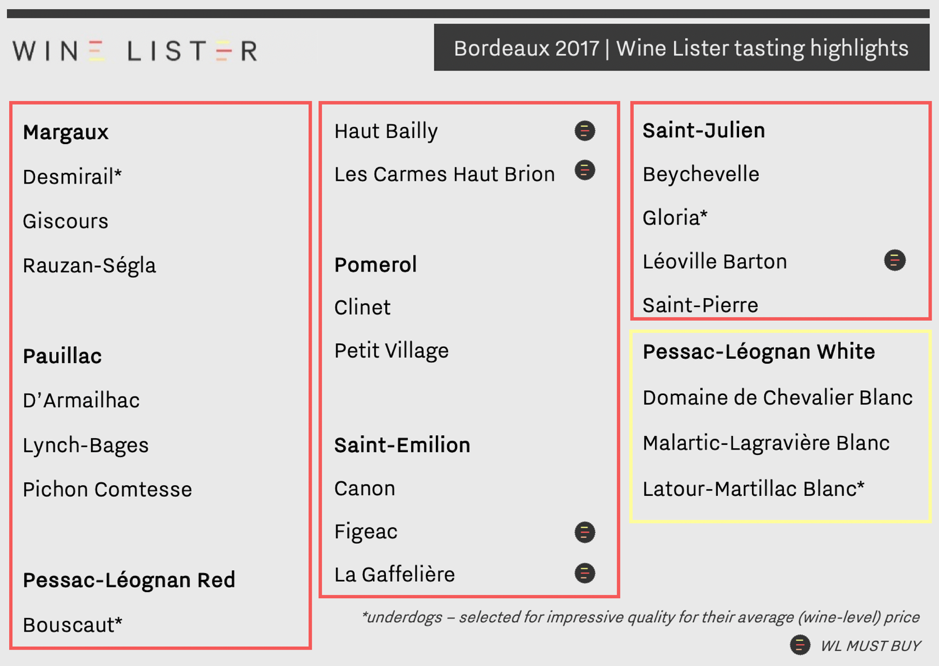
The team’s highlights include five out of the six 2017 Bordeaux WL MUST BUYs (vs. 19 in 2018 Bordeaux), while the other 16 are those we felt showed the best of those in attendance at the UGC tasting, in the context of the 2017 vintage.
Saint-Julien was our top-performing red appellation, with exemplary wines such as “poised” Léoville Barton, as well as two great successes from Domaines Henri Martin: Saint-Pierre was a “real triumph in the vintage,”, while underdog Gloria was “lithe, lovely, and beguiling”. Elsewhere on the left bank, Margaux and Pauillac earn three highlights apiece, including “hedonistic” Giscours and Wine Lister’s top pick of the tasting, “magical, brooding” Pichon Comtesse.
Pessac-Léognan performed equally well for whites as reds. Domaine de Chevalier Blanc was “explosive yet precise”, and underdog Latour-Martillac Blanc showed impressive roundness and balance. Haut Bailly had “an incredible elegance”, while Les Carmes Haut Brion showed “purity and savoury spice”.
Saint-Emilion’s Figeac was the best of the right bank bunch – “muscular” in texture but balanced by “succulent fruit”. Pomerol was well-represented by “floral and velveteen” Clinet, and “powerful” Petit Village.
Other wines included in Wine Lister’s 2017 tasting highlights are: Rauzan-Ségla, D’Armailhac, Lynch Bages, Bouscaut, La Gaffelière, Canon, Beychevelle, and Malartic-Lagravière Blanc.
Wine Lister has almost 150 new MUST BUYs. Since we launched MUST BUYs officially in September, the list has been updated based first on the most recent prices and relative regional or appellational value within vintages, and subsequently on Wine Lister’s most recent trips and tastings. The full MUST BUY list has reduced by 109 (1,693 wines vs. 1,802), and includes 149 new entries.
Perhaps unsurprisingly, 62 (or 42%) of new MUST BUYs hail from Burgundy. The 2017 vintage (released for the most part at the beginning of this year) yields 17 results, all worth getting hold of before availability reduces, and prices inevitably rise. Antoine Jobard achieves three mentions, all for 2017 Meursaults (Genevrières, Blagny, and Les Tillets), while Burgundy négociants are well-represented by additional MUST BUYs from Maisons Louis Latour, Louis Jadot, and Joseph Drouhin, who now count totals of 14, 42, and 20 MUST BUYs respectively. The Maisons de Négoce increasingly represent unparalleled value for money as the quality of their wines continues to increase, while their prices have not exploded in the same way as for many domaine wines.
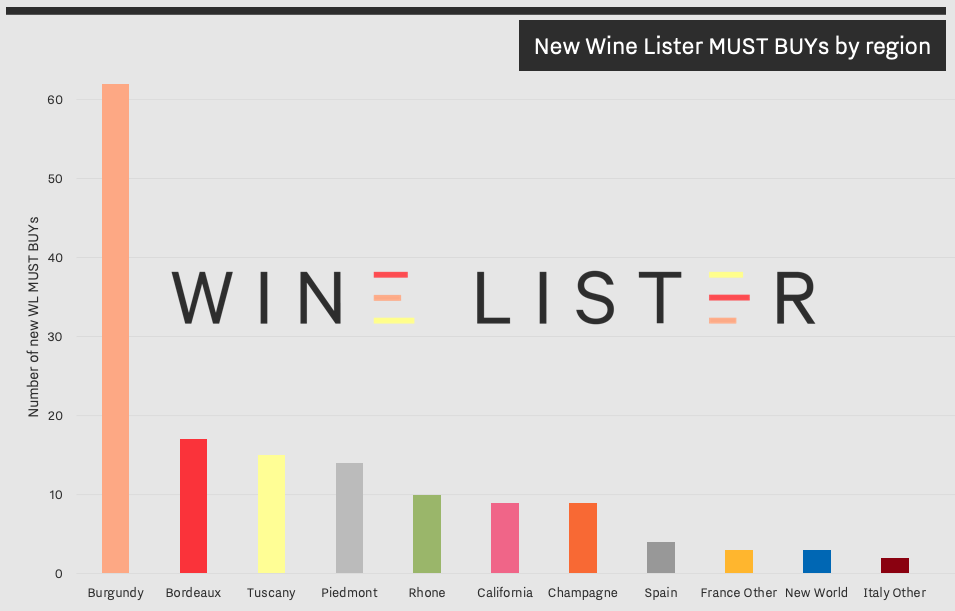
Bordeaux gains 17 new entries, including a 2018 en primeur listing – Domaine de Chevalier Blanc. The remaining new Bordeaux MUST BUYs are mainly older vintages, with premiers and deuxièmes crus from 1982-1999 that are worth uncovering ahead of the festive season. Two Value Picks stand out from the Wine Lister team’s own tasting experiences of late – Capbern 2014 and Haut Carles 2015.
Italy reaps particular success in this new round of MUST BUYs, with 31 listings in total, split between Piedmont (14), Tuscany (15), Veneto (1), and Sicily (1). Gaja leads the charge in Piedmont with two vintages a piece for Barolo Sperss (2005 and 2014), and Barbaresco Sorì San Lorenzo (2005 and 2007). In Tuscany, a fourth vintage of Soldera’s Case Basse makes it into the MUST BUY list (1999), alongside existing MUST BUY vintages 2008, 2009, and 2013. The indomitable Castello dei Rampolla also gains an additional vintage each for Sammarco (1991), and Alceo (2008), making it the most “essential” producer to buy in Italy.
The Wine Lister team was pleased to be able to select from new wines rendered by the MUST BUY algorithm a few gems from recent tastings, including Deutz Cuvée William 2008 and Pierre Péters Cuvée Spéciale Les Chétillons Blanc de Blancs 2010 from a recent trip to Champagne, and Cheval des Andes 2016 – one of the team’s favourites from the September releases through the Place de Bordeaux.
All MUST BUYs are qualified by a minimum quality level, but at the very top of the new MUST BUY scoreboard are 16 wines with WL scores of 97 and above. While Burgundy outperforms Italy in number of new MUST BUYs, they each earn five places in the top scorers, as shown below.
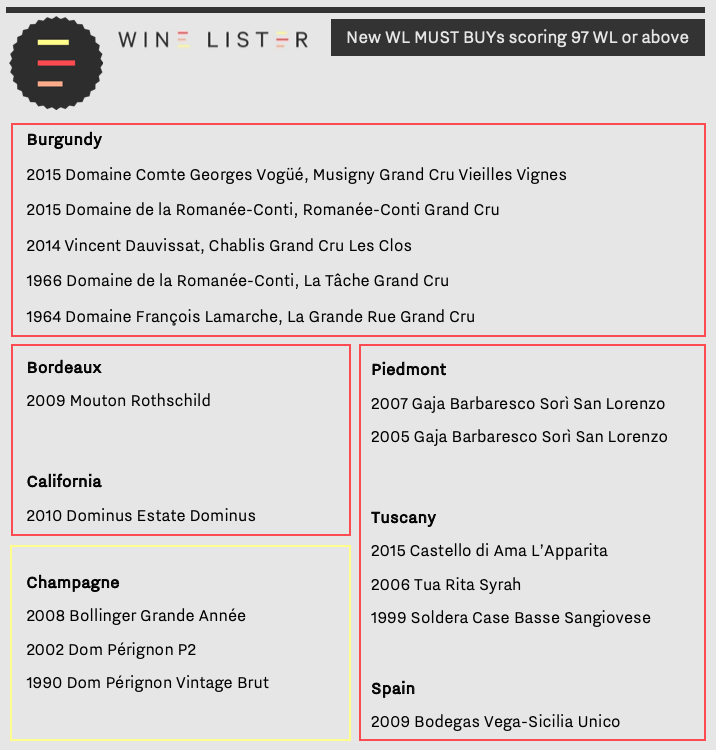
See the full list of MUST BUYs here, and watch this space for weekly MUST BUY updates from here on in.
In Piedmont, the 2019 harvest is late (compared to recent standards). Most Dolcetto was already picked when I visited last week, but healthy Nebbiolo bunches were still hanging on the vines (apart from those of early-picking maverick Roberto Voerzio, whose harvest finished on 23rd September, before anyone else had started). Most growers started harvesting Piedmont’s noble grape this week (the second week of October). At Gaja this was around a fortnight later than the already late vintage of 2016, which Gaia Gaja cited as similar for its great quality and quantity.

Left: the only grape-free Nebbiolo vines spotted in Piedmont last week, at Roberto Voerzio (with hail-protecting nets that stay on all-year round and last for 15 years). Right: recently picked vines at Tenuta Tignanello in Tuscany.
It has been a late year since the start: the first drought was in February and March, so there was “no energy for vegetation to develop,” explained Gaja. “In April we got rain but it was cold, so no sicknesses developed,” she continued, expressing relief that there was no replay of 2018’s almost tropical spring. There was a “shocking jump in temperature” on 25th June. With the grapes still all green, at 40°C for almost a week, some grapes burned, “even though we hadn’t touched the canopy by then, but very old vines don’t have so many leaves to protect the grapes,” explained Gaja. Then on 7th and 8th July, 200ml of much-needed rain fell. An accumulated delay was increased further by the higher quantity of grapes for each vine to ripen.
At Bartolo Mascarello, the Nebbiolo harvest is starting around now, which is especially late given that Barolo itself – where Mascarello’s vines are – ripens earliest of all the Barolo villages. However, such a late harvest has become an exception with the world heating up. “The rules have become the exceptions,” mused Maria-Teresa Mascarello, when I asked her about the usual timing for malolactic fermentation at Bartolo Mascarello. “There is no normal time for malo’ any more with so many early vintages,” she answered.

Maria-Teresa Mascarello in the Bartolo Mascarello winery in Barolo, explaining that the rules have become the exceptions due to climate change.
The 2019 harvest might seem late compared to recent, hot vintages, but at Pio Cesare, Augusto Boffa tells me that picking in the last week of October or the first week of November used to be the norm. This is why the winery advocates the Barolo “classico” (they understandably prefer this terminology to “basic” or “standard”) – a blend of many different villages. It is “the only way we can guarantee consistency,” although he adds that, “there used to be more worries on this front climatically.”
A five-hour drive further south, in Chianti, harvest is also on the late side. At Castello di Ama, winemaker Marco Pallanti had to postpone the last day of picking due to some light rain on the morning of Thursday 3rd October. The same spring rain and dry August delayed the vines in Tuscany as in Piedmont. Pallanti was very happy with what had been picked and vinified so far. The wines have “good colour and structure,” he told me, likening the quality level to 2015 and 2016, though quantity is around 20% down on last year.
The wet, cold May and torrid summer have also delayed the vines at Tenuta Tignanello, where they were running the risk of rain to achieve the right balance of sugars and polyphenolics. While the season “started very late and is very long,” said CEO Renzo Cotarella, “the vines didn’t suffer,” he continued, leading to “very balanced grapes” and vines “that still look unstressed even now.” He compares 2019 to 2016 and 2010, saying it is “more fresh than powerful”. If 2019 is anything like the 2016s (“the best we’ve ever made”, declares Cotarella) then we’re in for a treat.*
*I was lucky enough to taste the 2016 and the 2009 Solaia side-by-side at the estate, and very excited to hear about an upcoming retrospective at The Ledbury in London being organised by Wine Lister’s partner critic Vinous. It will include those two vintages and go all the way back to 1978. Renzo Cotarella will be there, as will Piero Antinori, with Antonio Galloni as host. Tickets are available here to Vinous subscribers or email info@vinous.com.
A new “normal” seems to be developing for Bordeaux.
After a fleeting trip around Bordeaux properties on both banks at the start of harvest, the Wine Lister team is excited to see the 2019 vintage take shape.
We must admit this was not our sentiment on the 23rd September, when, on arrival in a dreary, damp Bordeaux, our first thought went to the poor pickers, and of course to the grapes and potential spread of disease in such wet conditions.
Thankfully this worry was quickly cast aside – “the grapes are in an incredibly healthy state. For grape health, this has been a dream year”, said Château Dassault’s Valérie Befve. This, she further explained, was thanks to the combination of a good spring without too much humidity, budburst that was a little cold but without rain, and a dry summer that was hot without having placed too much water stress on the majority of the vines.
The summer heat wave and consequential drought, similar in timing and nature to 2018 (and to an extent, 2016), will likely result in another year where freshness and caution in extraction are key. Befve put this succinctly, noting that the “skin to juice ratio will require delicate management”. This theme, recurring in several of the last Bordeaux vintages, highlights the importance of careful handling in the cellars, and explains in part the purposeful movement towards a fresher, more approachable style, and away from big tannins and high alcohol that need time in bottle to soften.
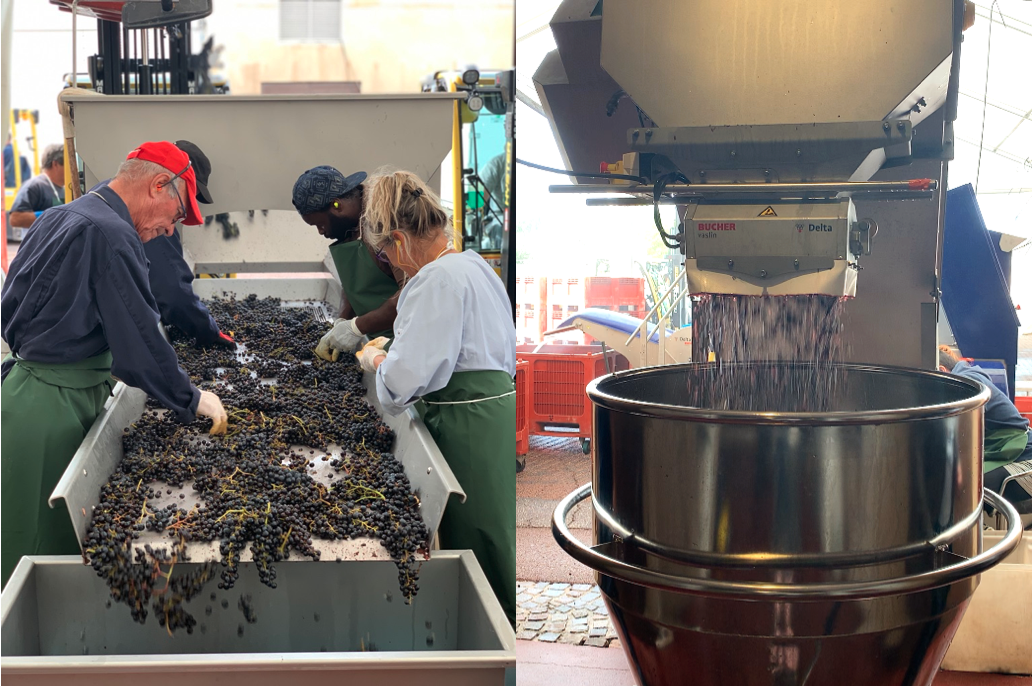
Left: Sorting of the first Merlot grapes at Pichon Baron. Right: Pichon Baron now uses small vats on wheels to transport freshly-picked grapes into fermentation tanks, since they cause less breakage of grape skins than traditional pumps.
Comparable characteristics seem in play on the left bank too. At Pichon Baron we tasted some of the very first 2019 Merlot grapes, and though the berries are a little smaller than usual (because of the drought), they are in perfect health. Axa Millésimes’ Commercial Director Xavier Sanchez was quick to say that it was far too soon to speculate on quality levels, but that the very early analyses “resembled 2018 and 2016”.
Grapes of high sugar content will need to be vinified with caution in order to balance potentially high alcohol levels. The rain that has fallen in the past 10 days will likely be a welcome gift to the Cabernet Sauvignon from the “grands terroirs” on this front, the majority of which are set to be picked this week.
Sara Lecompte Cuvelier, Managing Director of Léoville Poyferré and Le Crock echoed the positive sentiment on the general quality of grapes for both her properties, in Saint-Julien as in Saint-Estèphe – “We’re hopeful it will be another beautiful vintage, for both quantity and quality this year”.
While successions of good years are by no means unusual for the bordelais, harvests following heatwaves are becoming a pattern. All that remains to be seen is how the winemakers of Bordeaux deal with this “new normal” in the cellar. We are looking forward to finding out next year!
Last week we introduced Wine Lister’s new toy, a dynamic guide to the ultimate wines any fine wine lover should consider for their cellar – WL MUST BUY. While the full list is approximately 1,800 recommendations strong, Wine Lister provides some useful segments to help cut into all that data, aside from the usual criteria that can be found in our advanced search function (region, price, colour, score etc).
Wine Lister Indicators are designed to provide suggestions for your specific buying purpose, whether it be to discover something new (Hidden Gems), impress at a dinner party (Buzz Brands), drink well without breaking the bank (Value Picks), or add to your investment portfolio (Investment Staples).
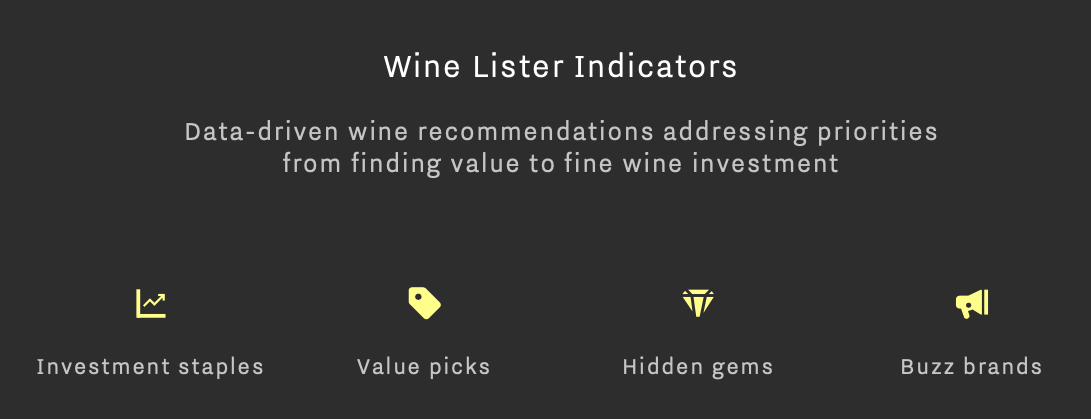
MUST BUYs and Indicators together provide a ready-made source list of the best wines to meet your needs. Below we look at the combination of our MUST BUY algorithm with Investment Staples.
Investment Staples are wines above a certain price, that are long-lived (but not too old), have proven wine price performance or represent good value compared to their peers, and are relatively stable and liquid, with recognition from our network of global fine wine trade members.
There are 18 MUST BUY Investment Staples that score 97 WL points or above. Perhaps unsurprisingly, Bordeaux represents almost half of these, with eight MUST BUYs, including two first growths (2016 Mouton, and 2016 Lafite), and 1975 Petrus.
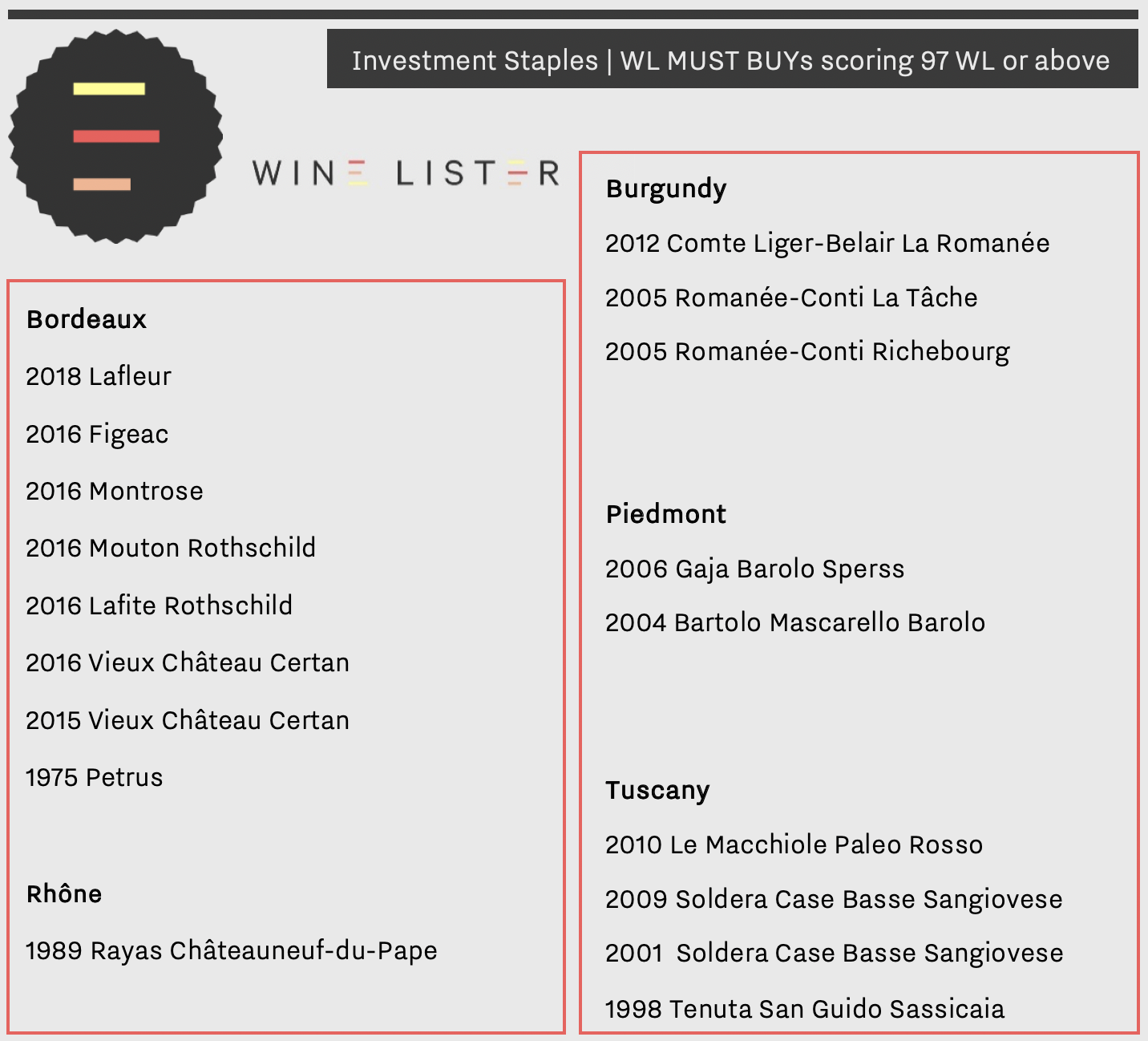
These eight Bordeaux have an average price of £511 per bottle, or just under an eighth of the average price of the three Burgundies to qualify as MUST BUY Investment Staples. However, as investments, some of them may require patience – the prices of those from 2016 have yet to increase any significant amount. By contrast, DRC’s La Tâche 2005, Richebourg 2005, and Comte Liger-Belair La Romanée 2012 are testament to Burgundy’s impressive upward price trajectory, having already achieved three-year CAGR (compound annual growth rates) of 21.8%, 23.4%, and 33.1% respectively.
Outside of Bordeaux and Burgundy, Italy holds court with MUST BUY Investment staples from Bartolo Mascarello, and the indomitable Soldera among others.
You can see the full list of MUST BUY Investment Staples here, or check out some other MUST BUY lists, such as MUST BUY Hidden Gems, or MUST BUY Value Picks.
Don’t forget that the MUST BUY list changes weekly. Revisit MUST BUY Investment Staples again next week to see new entries.
 Pictured: Charles Lachaux says when building his vines into arches, “there’s only one rule: there are no rules”.
Pictured: Charles Lachaux says when building his vines into arches, “there’s only one rule: there are no rules”. Kicking off Burgundy week tastings with Goedhuis at the Philip Mould Gallery, featuring producers such as Tortochot, Domaine de l’Arlot, Benjamin Leroux, and Jean-Marc & Thomas Bouley to name but a few.
Kicking off Burgundy week tastings with Goedhuis at the Philip Mould Gallery, featuring producers such as Tortochot, Domaine de l’Arlot, Benjamin Leroux, and Jean-Marc & Thomas Bouley to name but a few.












